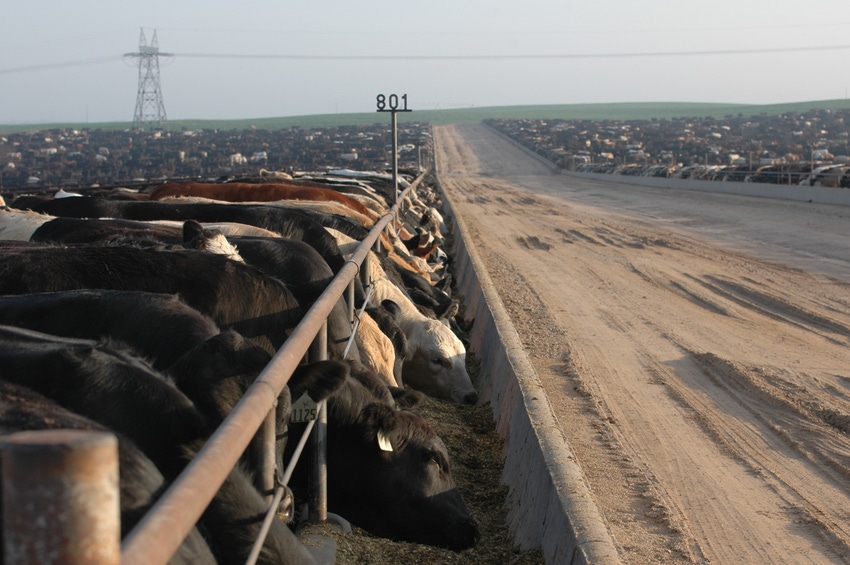Demand for feeder cattle continues strong
Although calves are starting to encounter some seasonal pressure, buyers continue to bid aggressively for feeder-weight cattle.
September 23, 2017

Buyers continued to bid aggressively for feeder cattle this week, receiving added support from a rally in futures prices.
Feeder steers and heifers traded mostly steady to $6 per cwt higher, according to the Agricultural Marketing Service (AMS). Prices were uneven for calves as more of them start coming to market. Some auctions reported steady to higher prices for heavier, weaned calves, while buyers generally applied more pressure to bawlers.
“Although improved forage conditions in the Southern Plains may increase incentives to background calves, placements in feedlots during the fourth quarter are expected to remain relatively large, given the availability of cattle outside feedlots,” say analysts with USDA’s Economic Research Service (ERS), in the monthly Livestock, Dairy and Poultry Outlook released this week. “However, expected declines in cattle feeding margins will likely encourage feedlots to bid down the price of calves in the coming months.”
The ERS price forecast for feeder steers (750-800 pounds) in the fourth quarter is $140-$146 per cwt. First-quarter prices are projected at $132-$140.
Feeder Cattle futures closed an average of $4.94 higher week to week on Friday ($3.17 to $6.90 higher).
In fact, the $11-$14 run higher in Feeder Cattle futures over the past month has prices at a point that seem to defy seasonal and conventional reality.
Based on fundamentals and history, Andrew P. Griffith, agricultural economist at the University of Tennessee explains in his weekly market comments, “A larger cowherd will lead to a larger calf crop this fall than has been seen in several years…The larger calf crop will pressure lightweight calf prices this fall from current levels. The larger supply of calves will also result in increased placements of cattle into feedlots (see below), which suggest softer prices.
Fed cattle trade $2 higher
Packers finally blinked on Friday in another week-long standoff with cattle feeders.
Live trade in the Southern Plains was $2 higher at $108 per cwt. Dressed trade was $2-$5 higher in the western Corn Belt at $170, with light live trade $1-$3 higher at $108. Elsewhere, there were too few transactions to trend.
Live Cattle futures closed an average of $2.96 higher week to week on Friday ($2.05 to $4.60 higher).
Higher fed cattle prices came with marginal help from wholesale beef values. Choice boxed beef cutout value was 18¢ higher week to week on Friday afternoon at $191.60 per cwt. Select was $2.88 higher at $188.73.
“Fed steer prices may possibly be pressured in the short-term as ample supplies of cattle are available to be marketed in the fourth quarter. In addition, an abundant supply of competing meats are also available,” ERS analysts say.
“Moving through the fall months, prices could always see another soft spot, but the expectation is for finished cattle prices to methodically improve heading toward the end of the year,” Griffith says.
ERS projects the fourth-quarter 5-area fed steer price at $107-$113 per cwt. Projections are $110-$120 in the first quarter of 2018.
Feedlot placements continue higher
If anything, the monthly Cattle on Feed report issued Friday could exert some psychological pressure at the beginning of next week, especially when it comes to placements.
Placements in August of 1.93 million head were 2.6% more than last year. That’s about 6% more than the average expected by analysts surveyed by Urner Barry and shared by Steiner Consulting Group this week in the Daily Livestock Report. Keep in mind that in round numbers, the increase represents about 49,000 more head.
In terms of placement composition, 55% of August placements went on feed weighing 799 pounds or less; 45% weighing 800 pounds or more.
Marketings in August of 1.98 million head were 5.9% more than last year, mirroring pre-report estimates.
So, the 10.5 million head on feed Sept. 1 were 3.6% more than a year earlier, which was about 1% more than expectations.
Derrell Peel, Extension livestock marketing specialist at Oklahoma State University provided some perspective on herd expansion and feedlot inventory at this week’s annual Kansas State University Beef Stocker Field Day.
Although monthly feedlot placements have been sharply higher for the past 15 months, in the wake of national herd expansion, Peel points out that monthly marketings were aggressive, too.
“As a result, we haven’t grown the feedlot inventory too rapidly,” Peel says.
Positive cattle feeding returns for much of this year encouraged feedlots to market cattle aggressively, helped along by robust domestic and international demand. Quicker turns through the feedlot and the resulting lighter carcass weights year over year continue to help mitigate the impact of increasing cattle numbers and beef production.
“It looks like we’re still growing the cowherd to some extent,” Peel says. He expects growth of 1% to 2% this year, then flat to minimal growth in 2018.
Although heifer slaughter is increasing, Peel says the steer-to-heifer slaughter ratio suggests slowing herd growth but certainly not liquidation.
USDA’s monthly Cold Storage report, released Friday, also speaks to the expected increase in beef production. Total pounds of beef in freezers Aug. 31 were
10% more than the previous month, but down slightly from last year.
For broader perspective, total red meat supplies in freezers were 7% more than the previous month, but 3% less than last year. Total frozen poultry supplies were slightly less month to month, but 6% more than a year earlier.
About the Author(s)
You May Also Like




.png?width=300&auto=webp&quality=80&disable=upscale)
